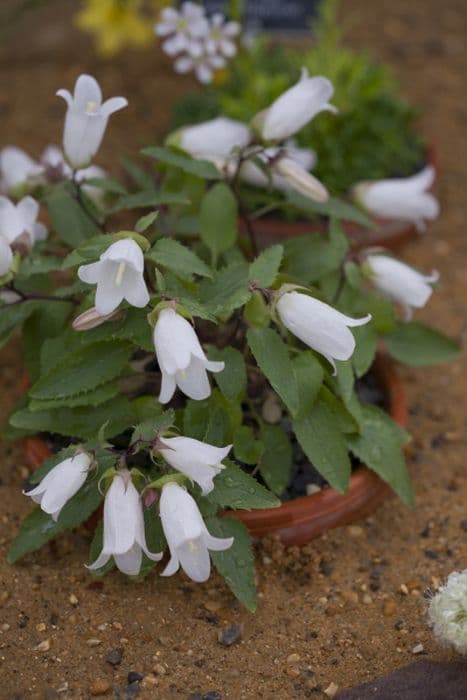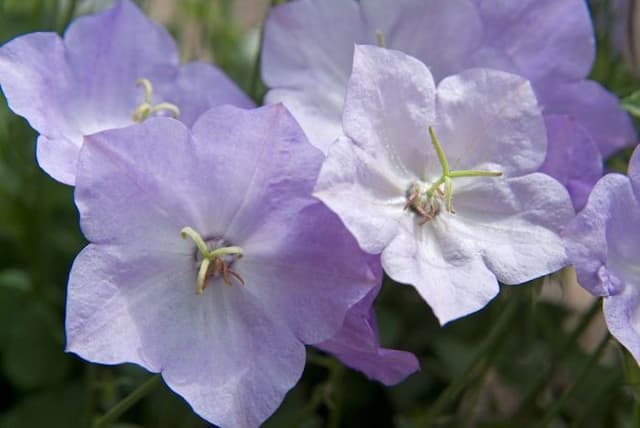Lobelia 'Weslowei' Lobelia White Star = 'Weslowei' (PBR)

ABOUT
[White Star] is a tender perennial grown as an annual, with spreading stems, fine foliage and glittering white flowers from late spring until autumn
About this plant
 Names
NamesFamily
Campanulaceae.
Synonyms
White Star Lobelia, Weslowei Lobelia.
Common names
Lobelia erinus 'Weslowei' (PBR)
 Characteristics
CharacteristicsLife cycle
Perennials
Foliage type
Deciduous
Color of leaves
Green
Flower color
White
Height
1 foot (0.3 meters)
Spread
1 foot (0.3 meters)
Plant type
Herb
Hardiness zones
Varies
Native area
Varies
Benefits
 General Benefits
General Benefits- Attracts Pollinators: The plant's flowers are known to attract bees, butterflies, and other beneficial pollinators to the garden.
- Ornamental Appeal: Lobelia White Star has striking white flowers that provide visual interest and enhance the aesthetic appeal of garden spaces.
- Versatility in Landscaping: It can be used in a variety of landscaping designs, including borders, containers, and as a part of flower beds.
- Drought Tolerance: Once established, it can tolerate periods of low water, making it suitable for drought-prone areas or water-wise gardens.
- Low Maintenance: It requires minimal care, apart from the occasional watering and deadheading, making it ideal for busy or novice gardeners.
- Seasonal Color: Offers a long blooming season, providing color and vibrancy to the garden from late spring to early fall.
- Compact Growth Habit: Its compact size allows it to fit into smaller gardens or spaces without overwhelming the area.
- Cold Hardy: It can withstand cooler temperatures, making it suitable for planting in a range of climates.
 Medical Properties
Medical Properties- This plant is not used for medical purposes.
 Air-purifying Qualities
Air-purifying QualitiesThis plant is not specifically known for air purifying qualities.
 Other Uses
Other Uses- Lobelia White Star can be used as a natural pest deterrent due to its attracting presence for beneficial insects that prey on common garden pests.
- Its striking white flowers can be used in moon gardens, which are designed to be enjoyed in the evening, reflecting moonlight and providing a glowing ambiance.
- The plant's compact size makes it suitable for use in terrariums or miniature fairy gardens, providing a sense of scale and white color contrast.
- Lobelia White Star can serve as a living mulch, covering the soil with its foliage to help retain soil moisture and suppress weed growth.
- The flowers of Lobelia White Star can be used in edible floral arrangements and as a decorative, non-toxic garnish for culinary dishes.
- It can be used in sensory gardens due to the soft texture and vivid color of its leaves and flowers, providing a tactile and visual experience.
- Lobelia White Star's structures, such as seed pods, can be used for artistic purposes like botanical printmaking and natural textile dyeing.
- Due to its cascading growth habit, Lobelia White Star can be employed in creating living walls or vertical gardens, adding a touch of elegance to urban spaces.
- This plant's dense foliage provides excellent ground coverage in between stepping stones, offering a natural, decorative pathway liner.
- In a garden setting, Lobelia White Star can be used to create a striking border or edge for garden beds and walkways with its low-growing habit.
Interesting Facts
 Feng Shui
Feng ShuiThe Lobelia is not used in Feng Shui practice.
 Zodiac Sign Compitability
Zodiac Sign CompitabilityThe Lobelia is not used in astrology practice.
 Plant Symbolism
Plant Symbolism- Regeneration and Renewal: The fresh, white blossoms of Lobelia can symbolize new beginnings and the cleansing of past worries, mirroring renewal that follows the plant's life cycle.
- Devotion and Trust: Given as a gift, Lobelia can represent steadfastness and a deep sense of trust between individuals.
- Attraction: The bright color and alluring shape of the flowers can symbolize an attraction that is both innocent and persuasive.
- Resilience: Lobelia, which can flourish in a variety of conditions, represents the ability to survive and thrive despite challenges.
 Water
WaterThe Lobelia 'White Star' prefers consistently moist soil, so it's important to water it regularly. Aim to water this plant once or twice a week, providing it with about 1 inch of water each time to ensure the soil remains evenly moist but not waterlogged. During hotter and drier periods, you may need to water the Lobelia more frequently to maintain soil moisture. Always check the top inch of soil before watering—if it's dry to the touch, it's time to water. Be cautious not to overwater as this can lead to root rot.
 Light
LightLobelia 'White Star' thrives best in full sun to partial shade conditions. The ideal spot for this plant would be an area where it can receive at least 4 to 6 hours of sunlight daily. If you live in a particularly hot climate, providing some afternoon shade will help protect the plant from excessive heat stress.
 Temperature
TemperatureLobelia 'White Star' prefers a temperature range between 60°F and 75°F for optimal growth, but it can tolerate temperatures as low as 50°F and as high as 85°F. To ensure healthy growth, avoid exposing the Lobelia to extreme temperatures outside of this range for prolonged periods.
 Pruning
PruningPrune Lobelia 'White Star' to encourage bushier growth and more blooms. Deadheading spent flowers periodically will stimulate continuous blooming throughout the season. Cut back the plant by about one-third in midsummer if it starts to look leggy or to rejuvenate its appearance. The best time for major pruning is in the early spring as new growth appears.
 Cleaning
CleaningAs needed
 Soil
SoilLobelia White Star prefers a rich, well-draining soil mix with a slightly acidic to neutral pH, typically ranging between 6.0 and 7.0. The best soil mix can be composed of peat, loamy soil, and perlite or sand to improve drainage.
 Repotting
RepottingLobelia White Star should be repotted every 1 to 2 years to prevent root-bound conditions and to replenish the soil with nutrients. Choose a slightly larger pot each time to accommodate the plant's growth.
 Humidity & Misting
Humidity & MistingLobelia White Star thrives in average to high humidity levels, ideally between 40% to 70%. Consistently high humidity will help maintain its lush foliage and support its blooming.
 Suitable locations
Suitable locationsIndoor
Ensure bright indirect light, keep soil moist.
Outdoor
Plant in partial shade with moist, rich soil.
Hardiness zone
6-9 USDA
 Life cycle
Life cycleThe Lobelia White Star, also known as Lobelia erinus 'Weslowei', begins its life cycle with germination from seed during the warm season or started indoors before the last frost for earlier blooms. After sprouting, the seedling grows into a young plant with characteristic foliage and begins to develop its root system. As it matures, the Lobelia White Star enters the vegetative stage, producing denser foliage and preparing for flowering. The flowering stage is marked by the appearance of the plant's distinctive white flowers, which attract pollinators and can last throughout the summer until the first frosts. After pollination, the flowers will produce seeds, completing the reproductive cycle. With the onset of colder weather, the Lobelia White Star will either die back if it is treated as an annual or may enter a period of dormancy if cultivated as a perennial in mild climates, ready to regrow the following spring.
 Propogation
PropogationPropogation time
Spring to Summer
The Lobelia White Star, with the cultivar name 'Weslowei' (PBR), is often propagated through seed sowing. The most popular method is to start seeds indoors about 10 to 12 weeks before the last frost date. It's imperative to use a well-draining seed starting mix, press the tiny seeds gently into the surface but do not cover them, as they need light to germinate. Keep the soil moist but not soggy and maintain a consistent temperature of about 70 degrees Fahrenheit (21 degrees Celsius). Given their size, it's also feasible to scatter the seeds on top of the soil. Seedlings usually emerge within 14 to 21 days. Once they have developed a few true leaves and there is no more risk of frost, they can be transplanted outdoors.









![Milky bellflower [Avalanche]](/_next/image?url=https%3A%2F%2Fplants-admin.emdemapps.com%2Fimages%2Fplants%2F%2Fimages%2F604b5dc88c1e7.png&w=640&q=75)